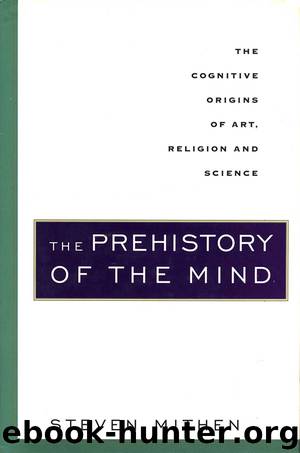The Prehistory of the Mind by Steven Mithen

Author:Steven Mithen
Language: eng
Format: epub
ISBN: 9780500772843
Publisher: Thames & Hudson
Published: 2015-04-19T16:00:00+00:00
24 Engraved bone plaque from Grotte du Taï, Drôme, France. Length, 8.8 cm.
It is likely that all types of artifacts, including those that might appear to be mundane tools for hunting or even processing animal hides, became imbued with social information at the start of the Upper Palaeolithic.63 In effect the ‘goal posts’ of social behaviour were moved; whereas for Early Humans the domains of hunting, toolmaking and socializing were quite separate, these were now so integrated that it is impossible to characterize any single aspect of Modern Human behaviour as being located in just one of these domains. Indeed as Ernest Gellner stated: ‘the conflation and confusion of aims and criteria, is the normal and original condition of mankind’.64
The rise of religion
Many of the new behaviours I have been describing, such as the anthropomorphic images in the cave paintings and the burial of people with grave goods, suggest that these Upper Palaeolithic people were the first to have beliefs in supernatural beings and possibly an after life. We are indeed seeing here the first appearance of religious ideologies. This can be explained by the collapse of the barriers that had existed between the multiple intelligences of the Early Human mind.
Just as we did with art, we must first reach some agreement on quite what we mean by the notion of religion. While it is difficult to identify features universal to all religions, there are nevertheless a series of recurrent ideas. The importance of these has been stressed by the social anthropologist Pascal Boyer in his 1994 book The Naturalness of Religious Ideas. Boyer explains that a belief in non-physical beings is the most common feature of religions; it may indeed be universal. In fact, ever since the classic work of E.B. Tylor in 1871 on Primitive Cultures, the idea of non-physical beings has been taken for the very definition of religion itself. Boyer notes three other recurrent features of religious ideologies. The first is that in many societies it is assumed that a non-physical component of a person can survive after death and remain as a being with beliefs and desires. Second, it is very frequently assumed that certain people within a society are especially likely to receive direct inspiration or messages from supernatural agencies, such as gods or spirits. And third, it is also very widely assumed that performing certain rituals in an exact way can bring about change in the natural world.
Sending social information by material culture: the Sungir burials
Download
This site does not store any files on its server. We only index and link to content provided by other sites. Please contact the content providers to delete copyright contents if any and email us, we'll remove relevant links or contents immediately.
The Art of Thinking Clearly by Rolf Dobelli(8841)
The 5 Love Languages: The Secret to Love That Lasts by Gary Chapman(8493)
Mindhunter: Inside the FBI's Elite Serial Crime Unit by John E. Douglas & Mark Olshaker(7833)
Becoming Supernatural by Dr. Joe Dispenza(7104)
Nudge - Improving Decisions about Health, Wealth, and Happiness by Thaler Sunstein(6633)
The Road Less Traveled by M. Scott Peck(6633)
Enlightenment Now: The Case for Reason, Science, Humanism, and Progress by Steven Pinker(6405)
Win Bigly by Scott Adams(6310)
Mastermind: How to Think Like Sherlock Holmes by Maria Konnikova(6234)
The Way of Zen by Alan W. Watts(5798)
Factfulness: Ten Reasons We're Wrong About the World – and Why Things Are Better Than You Think by Hans Rosling(4021)
The State of Affairs by Esther Perel(3926)
Gerald's Game by Stephen King(3918)
Man's Search for Meaning by Viktor Frankl(3631)
The Confidence Code by Katty Kay(3566)
Thinking in Bets by Annie Duke(3530)
The Worm at the Core by Sheldon Solomon(2917)
Enlightenment Now by Steven Pinker(2913)
Liar's Poker by Michael Lewis(2810)
